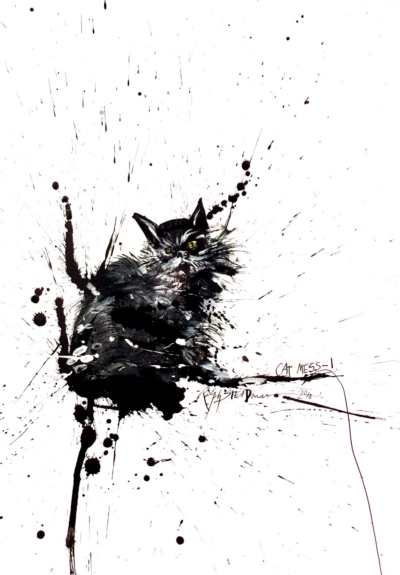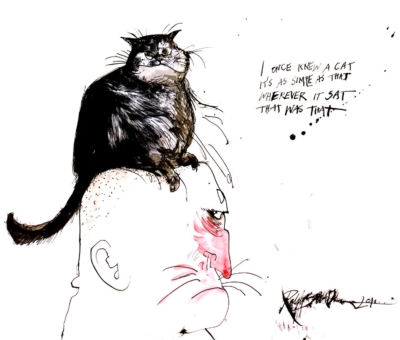
I am trying to figure out if I like cats. Not whether I adore them, love them, even admire them, but whether I can tolerate them at all.
Many people have a phobia about cats. They are known as ailurophobes. Believe it or not, famous leaders, usually dictators, feared cats. Genghis Khan loathed them, as did Alexander the Great. Phobias are deeper feelings than dislikes and can cause sweating and palpitations, nausea, lack of breath and a dry mouth. That is a horrible condition to suffer simply because you happen not to like cats! They cannot help being cuddly things that wrap themselves around your ankles, because they want to be stroked and made a fuss of, but that is why people get the creeps and wonder what else they want: they don’t want anything else.
But they don’t want to give you anything either! They never contribute a goddamn thing to the world, and they just want feeding for free. If a cat “adopts” you it is a kind of curse. You are supposed to feel grateful because – in a sort of way – they will clean you out of rodents. That, they are good at, and they carry out that odious task like slaves, though to them they are fulfilling a deep craving of their own, so never feel sorry for them. This soft, purring mammal is probably the single most self-centred beast in all of nature. That is probably why they give us the creeps!
Cats protected the food in barns and one-time pantries. It was convenient for both: cats got what they wanted and we got purring sycophants with an agenda. This did not go unnoticed by the Egyptians. While the exact history of this human convenience is not quite clear, the Egyptians made cats into god effigies and established them as ethereal beings with minds that are only their own. Cats languish loved or hated inside this fantasy.
Cats, known in Egypt as mau, naturally played a large role in ancient Egyptian society. They were associated with the goddesses Isis and Bast. It was believed that the saliva of cats contained a toxin that could be used to treat syphilis, memory loss, skin virus, bad eyesight, lumps of all kinds, joint degeneration, anxiety tremens and depression.
In medieval Europe cats were often associated with the Devil and all his ways; they were assumed to be in league with the ole bugger thanks to their aloof and independent nature. When the Black Death hit, cats were massacred in great numbers. How very ironic.
Cat facts: contained within the word “facts” is the word “cats”. Vikings used cats as rat catchers and companions. A medieval King of Wales, Hywel Dda (the Good), passed legislation making it illegal to kill or harm a cat.
In medieval Ypres cats were used in the winter months to control the vermin infesting the wool stored in the upper floors of the Cloth Hall (Lakenhall). At the start of the spring warm-up, after the wool had been sold, the cats were tossed out of the belfry tower to the town square below, which supposedly symbolised “the killing of evil spirits”. In today’s Kattenstoet (Cat Parade) this has been commuted to the throwing of toy cats from the belfry.
Folklore dating back as early as 1607 tells that a cat will suffocate a newborn infant by putting its nose to the child’s mouth and sucking out its breath.
 Black cats are generally held to be unlucky in the United States and mainland Europe, and to portend good luck in the United Kingdom. In the latter country, a black cat entering a house or ship is a good omen, and a sailor’s wife should have a black cat for her husband’s safety on the sea. White cats, bearing the colour of ghosts, are conversely held to be unlucky in the United Kingdom, while tortoiseshell cats are lucky.
Black cats are generally held to be unlucky in the United States and mainland Europe, and to portend good luck in the United Kingdom. In the latter country, a black cat entering a house or ship is a good omen, and a sailor’s wife should have a black cat for her husband’s safety on the sea. White cats, bearing the colour of ghosts, are conversely held to be unlucky in the United Kingdom, while tortoiseshell cats are lucky.
It is common lore that cats have nine lives, which is a tribute to their perceived durability, their occasional apparent lack of instinct for self-preservation, and their seeming ability to survive falls that would be fatal to other animals. It also helps explain why cats are the most smug, self-satisfied creatures on God’s earth.
They smooch around your ankles never expecting a swift kick, and neither do they get one! They sidle into your best patch of freshly growing parsley, drag up the seedlings and then pee right on that spot! Then they carefully cover up what they have done with what it is they have disrupted, tremble their filthy backsides in that direction, and then saunter off as though they had just blessed the earth like a priest.
Ralph Steadman’s first cat was called Tishy, because it rhymes with “fishy”. His Book of Cats is published by Atlantic Books. Ralph Steadman has decided he hates cats

